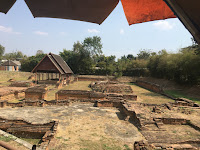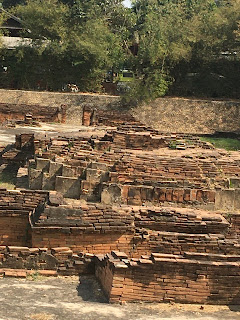I know, Captain. But this time it was a little different.
Horse.
What?
You said it was different, Spike, and I agreed. It was different because of the horse.
Is that all you remember for a difference?
I think it's an important difference, don't you?
Sometimes I wonder about you, Captain. Wiang Kum Kam is the second capital of the Lanna Kingdom. It is an archaeological site and ancient ruins. When we went to the Old City of Chiang Mai, that was where they had to move the capital.
Well, yes. But there weren't any horses there. I like horses almost as much as elephants, you know.
ANYWAY. When we were in Chiang Mai, we visited Wiang Kum Kam. This area actually has several different sites, and there are trams for large groups and horse and buggies for small groups to travel between the sites. Each site is situated in a neighborhood beside parks, houses, and businesses. The guides are volunteers and have hand-outs in different languages to learn about each site.
We visited six temple sites from the ancient city. The city was built in the 14th century when the capital was moved from Chiang Rai to Chaing Mai. However, as the river flooded the city frequently, the king moved the capital to the area now known as the Old City. The site was buried under two meters of sediment and rediscovered in 1984.
 |
| Kuu Par Dom or Kuu Padom |
Kuu is the ancient local word for pagoda. Kuu Pa Dom was our first stop. We had to stay in the buggy because they are excavating under the roofed area.
Then we continued on to Wat Kan Thome or Wat Chang Kham. Chronicles report this was built by King Mengrai in 1290. The chedi in the basement is 12 by 18 meters with several Buddha images.
The statue of King Mengrai is in a building believed to be the spirit chamber for the king. This is a holy site for the people of Chiang Mai. Tradition states the spirit of King Mengrai resides inside it.
Quite a few sites we saw as we drove past and did not stop.
When we got to Wat I-Khang, we learned that archaeologists don't know the name of this site. They cannot find it in any ancient documents. This had a large rectangular assembly hall with a pedestal for the Buddha image and a bell-shaped stupa in the Lanna style.
 |
| Wat I-Khang |
Our next site was Wat Nanchang (Nan Chang). This site was a bit different because on top of the most ancient buildings were other buildings that had been build on top of the sediment. The first period had a main gate porch and a wall. These were connected with an assembly hall and a chedi. The second period of buildings had larger grounds and more buildings, including a stairway of a Magara with a Naga coming out of its mouth. The wat was named after the ancestors of the people who owned this land when the ruins were discovered. Interestingly, porcelain from the Ming Dynasty was discovered buried in jars here.
Wat Pu Pia has its name from an interesting source. Pu Pia means "short old man" in the local dialect. A "short old man" had built a house on the temple grounds when they were deserted and before excavation.
By this time, I was tired. I don't know about Captain, but it was a hot day and I was glad we weren't walking!
I was out of water, so I was wondering at this point how much longer we would be exploring! Then I forgot about being thirsty when we arrived at Wat That Khao. Here a large Buddha image had been discovered; its head was missing, but the villagers repaired it and have it at the site for worship. This temple is from the 15th century. It's named the Temple of the White Reliquary because its stupa was covered in limestone.
Our final stop, and a well-deserved water break, had two sites in one. Jedee Liam (Kuu Kham) is inside the grounds of Wat Chedi Liam. Jedee Liam was given to Chiang Mai by King Mengrai in the 13th century. It is a pyramid shaped pagoda (Chedi = Jedee) in five layers with a total of sixty Buddha images on the four sides. This was one per wife for the king. Women are not allowed inside the wall surrounding this chedi even though it was built to help ensure his wives went to heaven.
Wat Chedi Liem is not a "modern" site event though it is around an ancient site. It was built not long after the chedi! It's name is "The Temple of the Square Pagoda."
At the end of our tour, we said goodbye to Toh, our horse, and were happy to have seen some of Chiang Mai's history.










































No comments:
Post a Comment